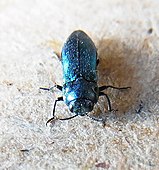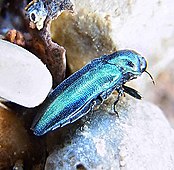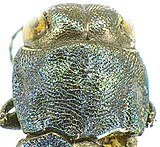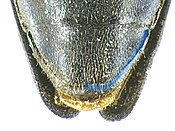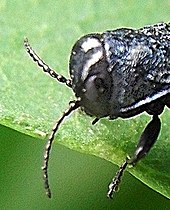Honeysuckle jewel beetle
| Honeysuckle jewel beetle | ||||||||||||
|---|---|---|---|---|---|---|---|---|---|---|---|---|
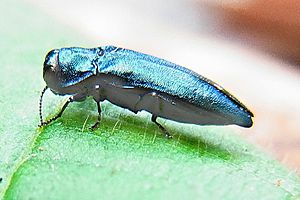
Agrilus cyanescens |
||||||||||||
| Systematics | ||||||||||||
|
||||||||||||
| Scientific name | ||||||||||||
| Agrilus cyanescens | ||||||||||||
| Ratzeburg , 1837 |
The stern cherry borer , in the first description Steel blue jewel beetle called ( Agrilus cyanescens is) a beetle from the family of the jewel beetle and the subfamily Agrilinae . The species-rich genus Agrilus comprises over 2800 species in 36 subgenera worldwide . In Europe there are currently 78 species, in Central Europe there are around 40 species. The delimitation of the species is occasionally still disputed.
The species is listed as critically endangered in the Brandenburg Red Lists. In Schleswig-Holstein it is considered endangered, in Saxony-Anhalt as extremely rare and potentially endangered.
Notes on the name
The species was first described by Ratzeburg in 1837 . Ratzeburg precedes his description that the species bears the species name cyanea in Herbst and Olivier , and that Illiger changed the name to cyanescens , since the name cyanea is used by Fabricius for another beetle. Ratzeburg commented on the change with the words and was right about it . Cyanea and cyanescens are derived from the Latin "cyánĕus" for "blue". Ratzeburg calls the beetle the "steel blue jewel beetle". The name honeysuckle jewel beetle refers to the host plant honeysuckle . Among the numerous synonyms , the synonym Agrilus coeruleus Rossi is often used in German-language older literature . Sometimes this species is viewed as different from Agrilus cyanescens with the current spelling Agrilus caeruleus .
The genus Agrilus was established by the Englishman Curtis in 1825. He took the name from Megerle . According to another source, the genus goes back to Dahl , 1823. The explanation of the generic name Agrīlus is uncertain. Schenkling provides his explanation (from ancient Greek άγρα ágra, hunting, prey, and είλω ēīlo, to gather) with a question mark. A reference to properties of the species of the genus is not discernible.
Physique of the beetle
The beetle becomes 4.5 to 7 millimeters long. It is one of the numerous metallic, shiny Agrilus species that can take on blue or green or an intermediate color. The bottom is black or the same color as the top.
The head (Fig. 8) is short and wide, the mouthparts point downwards. The short, eleven- link antennae are bluntly sawn towards the inside from the fourth link onwards. They are deflected between the eyes just above the line connecting the lower edge of the eyes. The upper lip is rectangular. The strong upper jaws are curved inwards. They are cut out on the inside and have a blunt tooth. The first jaw member is very small, the second long, the third smaller and triangular, the fourth again thick and egg-shaped. The end link of the tripartite lip probe is large and somewhat club-shaped. The large eyes are on the side of the head and almost reach the front edge of the pronotum, but are remarkably small compared to other Agrilus species. An important distinguishing feature is the bald forehead with a distinct frontal furrow (Fig. 4 and 8).
The pronotum (Fig. 4) shows a shallow central furrow. As a characteristic of the species, it has a double side border. This consists of the actual side edge and a keel-like elevation running below it. The posterior angles of the pronotum are, according to the standard work Freude-Harde-Lohse, without keels , according to Redtenbacher with a more or less sharp ridges . Images on coleopterological websites show animals with and without keel-like structures in the rear corners. On the sides of the pronotum this is slightly indented, the impression is densely wrinkled dotted (in Fig. 4 especially visible on the right) and not smooth or at most individually dotted as in Agrilus pseudocyaneus . The front edge of the pronotum is slightly concave behind the eyes. The rear edge is distinct in front of each wing cover, almost angularly curved towards the front, slightly drawn forward in front of the label.
The wing covers are somewhat enlarged behind the middle. A gradual escalation follows. Each wing cover ends in a rounded shape (Fig. 5 in depth), the tip is only very finely serrated (Fig. 7). The elytra are inconspicuously short and darkly haired, so that they appear bald.
The species belongs to the Agrilus species whose triangular, sharply pointed label in the middle has a sharply raised transverse keel in the middle (Fig. 6, right half of the transverse keel tinted blue). A transverse furrow extends behind it.
The anal sternite has a marginal furrow that is edged at the back (drawn in blue on the right in Fig. 5). The front chest (Fig. 3 right blue) is continued both towards the head (in Fig. 3 green, chin process) and backwards (Fig. 3 red, prostate process). The collar or bib-shaped chin extension protrudes downwards like an apron and is cut out in the middle. According to the first description, this thoracic process is very deeply bulged, according to Redtenbacher, on the other hand, it is slightly cut out . According to the standard work Freude-Harde-Lohse, the chin process is particularly strong in males and occasionally weak . The rear extension of the front chest runs between the front hips (yellow on the right in 3) into a recess in the mid-chest. The edges of this process are neither curved nor divergent between the front hips, but run parallel here (Fig. 3 right). This is an important feature in separating the many species of Agrilus. The first link of the hind tarsi is as long as the two following links together. Anterior and middle tarsi are widened like lobes. All tarsi are five-part. The claws are serrated at the base. In the honeysuckle jewel beetle, these teeth are short and wide in both sexes and do not simulate split claws.
biology
The beetle appears from late spring, in Baden-Württemberg from May to August with the maximum in June. The species is preferably found in deeper areas, but reports from Baden-Württemberg are also found from 1200 meters above sea level. M. before.
The animals do not appear until late in the morning, sit relatively lazily in the sun and let themselves fall quickly if they are disturbed.
The main host plants are honeysuckle species , in Baden-Württemberg mainly the red honeysuckle . However, numerous other deciduous trees are mentioned, so that the species is traditionally classified as polyphagous . The larva develops in already damaged or ailing thinner branches up to a diameter of one centimeter. The winding feeding tunnels run under the bark. The excursion hole is round.
distribution
The distribution area of the species extends in a north-south direction from Denmark to Spain, Italy and the former Yugoslavia, in a west-east direction from France to China. The species was also introduced to North America.
literature
- Fritz Brechtel, Hans Kostenbader (ed.): The splendor and stag beetles of Baden-Württemberg. Eugen Ulmer, Stuttgart 2002. ISBN 3-8001-3526-4 , p. 248
- Heinz Joy, Karl Wilhelm Harde, Gustav Adolf Lohse: The beetles of Central Europe . tape 6 : Diversicornia . Spectrum, Heidelberg 1979, ISBN 3-87263-027-X . P. 230ff
- Gustav Jäger (Ed.): CG Calwer 's Käferbuch . K. Thienemanns, Stuttgart 1876, 3rd edition p. 336 as Agrilus coeruleus
- Klaus Koch : The Beetles of Central Europe Ecology . 1st edition. tape 2 . Goecke & Evers, Krefeld 1989, ISBN 3-87263-040-7 . P. 103
- Edmund Reitter : Fauna Germanica, the beetles of the German Empire III. Volume, KGLutz 'Verlag, Stuttgart 1911 p. 194 as Agrilus coeruleus
Individual evidence
- ↑ a b c Agrilus cyanescens at Fauna Europaea. Retrieved December 12, 2013
- ^ Taxon profile Agrilus Curtis 1825 BioLib, accessed December 12, 2013
- ↑ a b Agrilus at Fauna Europaea. Retrieved December 9, 2013
- ↑ Coleonet: the beetles Europe, Agrilus accessed on December 12, 2013
- ↑ Red lists at Science4you
- ↑ a b Julius Theodor Christian Ratzeburg: The forest insects or illustration and description of the insects that have become known as harmful or useful in the forests of Prussia and the neighboring states, 1st part, Berlin 1837 p. 54f preview in the Google book search
- ↑ Sigmund Schenkling: Explanation of the scientific beetle names (species)
- ↑ a b Eduard Jendek, Vasily v. Grebennik: Revision of the Agrilus cyanescens species-group (Coleoptera: Buprestidae) with description of three new species from the east Palaearctic region Zootaxa 2139: 43-60 (2009) ISSN 1175-5326 (printed), ISSN 1175-5334 (online) PDF
- ^ John Curtis: British Entomology ... The Genera of Insects ... Vol. II Coleoptera Part II, London 1823–1840 Description of the genus Agrilus in the text on Plate [50] corresponds to plate 67
- ↑ at AnimalBase
- ↑ Sigmund Schenkling: Explanation of the scientific beetle names (genus)
- ↑ a b Fauna austriaca. The bugs. According to the analytical method, edited by Ludwig Redtenbacher 3rd edition Vienna 1874 at BHL p. 516 under coeruleus
